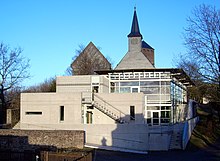Palatinate Museum for Natural History
 Entrance area of the Palatinate Museum in Bad Dürkheim |
|
| Data | |
|---|---|
| place | Bad Dürkheim |
| Art |
Natural History Museum
|
| opening | 1981 |
| management |
Frank Wieland
|
| Website | |
| ISIL | DE-MUS-006711 |
The Palatinate Museum of Natural History - Pollichia Museum is a natural history museum established in 1981 in the Upper Palatinate spa and district town of Bad Dürkheim ( Rhineland-Palatinate ). A branch of the Palatinate Museum is the Urweltmuseum GEOSKOP at Lichtenberg Castle near the Westphalian district town of Kusel .
Since 1998, both institutions have been sponsored by the Palatinate Museum for Natural History Association , which was formed by the Palatinate District Association , the City of Bad Dürkheim, the Bad Dürkheim and Kusel Districts and the POLLICHIA (Association for Nature Research and Conservation).
Geographical location
The Palatinate Museum is located in the former Herzogmühle am Herzogweiher , a reservoir of the Isenach in the Bad Dürkheim district of Grethen , which is located in the Isenach valley west of the city center.
Exhibition and educational offer
Since 1981, the museum has presented the scientific collections of the Association for Natural Research and Land Care POLLICHIA as well as a permanent exhibition and temporary exhibitions on scientific topics. One of his most famous exhibits is the Krähenberger meteorite that fell on the Sickinger Höhe in 1869 .
Scientific working groups deal with the topics of astronomy , reptilian studies , ornithology and mineralogy . There are extensive educational museum offers for visitor groups and school classes.
In 2016, the Pfalzmuseum was awarded the ArtFinder as a contribution to the UN Decade of Biological Diversity for its museum educational project Pfalzmuseum on the road .
Museum management
At the end of 2015, the previous museum director Reinhard Flößer (* 1952) retired after almost 21 years in office. His successor is the zoologist Frank Wieland, born in 1975 , who has worked at the Palatinate Museum since 2013 and whose specialty is entomology .
Construction work
In the course of 2008 the museum was expanded. First, a building that used to be the Herzogmühle restaurant was demolished and a new extension was built. On November 8th, 2008 the new entrance area as well as rooms for conferences and special exhibitions were inaugurated.
As a result, the renovation of other parts of the building began, so that the exhibition was temporarily not fully accessible.
Urweltmuseum GEOSKOP
In 1998, the GEOSKOP primeval world museum was opened as a branch at Lichtenberg Castle in the west of the Palatinate near Kusel. It is 374 m above sea level. NHN ( ⊙ ).
On an area of about 400 m², which are spread over two floors, the GEOSKOP provides an insight into the age of the Rotliegend about 290 million years ago. At that time the southern and northern continental masses collided in this area, the Variski Mountains were formed and a warm, humid tropical climate prevailed.
An approximately 300 million year old primeval reptile , the fossil remains of which were found in the nearby Remigiusberg Formation in 2002 , was given the scientific name Cryptovenator hirschbergeri in 2011 ; with the naming was Winfried Jeleniogórska honored belonging 1985-2017 as district to the museum conveyors. According to the museum, the find exhibited in the GEOSKOP is the oldest evidence of the occurrence of reptiles in Germany.
Another focus in the exhibition area is mining in the North Palatinate Bergland and in the neighboring Hunsrück with special consideration of the living and working conditions of the miners . Deposits such as those of copper and mercury ores were mined from the Celtic and Roman times until the beginning of the 20th century.
In 2014, GEOSKOP received the environmental award of the State of Rhineland-Palatinate for the research workshop project for people aged 5 and over , which is subtitled 25 years of environmental education at Lichtenberg Castle .
In addition to the museum shop , the building also houses a paleontological workshop and the geological reference library .
Web links
Individual evidence
- ↑ The future of the Pfalzmuseum secured. In: www.bv-pfalz.de. August 6, 2018, accessed February 1, 2020 .
- ↑ Offers. pfalzmuseum.de, accessed on December 2, 2015 .
- ↑ Contribution to the UN Decade of Biological Diversity 2016. pfalzmuseum.de, accessed on June 4, 2020 .
- ^ A b Jürgen Müller (jüm): The Palatinate Museum coined. In: Die Rheinpfalz , online version. December 1, 2015, accessed on December 5, 2015 (fully accessible only to subscribers).
- ↑ Jürgen Müller (jüm): "I feel at home here" . In: Die Rheinpfalz , complete edition . Section Südwestdeutsche Zeitung, No. 281 . Ludwigshafen December 3, 2015, p. 12 .
- ↑ Archive press releases 2005–2014. pfalzmuseum.de, accessed on December 2, 2015 .
- ↑ Map service of the landscape information system of the Rhineland-Palatinate nature conservation administration (LANIS map) ( notes )
- ↑ a b Cryptovenator hirschbergeri. schaudochnach.de, November 17, 2011, accessed on December 2, 2015 .
- ↑ Cryptovenator ( Greek / Latin ): Hidden Hunter .
- ↑ Jörg Fröbisch, Rainer R. Schoch, Johannes Müller, Thomas Schindler, Dieter Schweiss: A New Basal Sphenacodontid Synapsid from the Late Carboniferous of the Saar-Nahe Basin, Germany . In: Acta Palaeontologica Polonica . tape 56 , no. 1 , April 21, 2010, p. 113–120 , doi : 10.4202 / app.2010.0039 .
- ↑ Umweltpreis 2014. urweltmuseum-geoskop.de, accessed on June 4, 2020 .
Coordinates: 49 ° 27 '41.1 " N , 8 ° 8' 58.3" E





